Analysis of Organizational Capacity at Chifley District Hospital
VerifiedAdded on 2022/08/29
|10
|2633
|18
Essay
AI Summary
This essay examines the organizational capacity of Chifley District Hospital (CDH), which currently employs a traditional bureaucratic structure. The analysis highlights the advantages, such as clear authority and defined roles, and limitations, like rigidity and constraints on expansion, of this structure. The essay emphasizes the importance of aligning the hospital's mission, vision, goals, and objectives with its organizational structure. It argues that the bureaucratic structure is inadequate for CDH's evolving needs, particularly given its goal of providing specialized care to a growing community. The essay recommends adopting a matrix organizational structure to foster professionalism, accountability, efficiency, collaboration, and effective resource utilization, ultimately improving communication, teamwork, and patient outcomes. While acknowledging potential complexities, the essay concludes that a matrix structure is best suited for CDH's strategic goals.
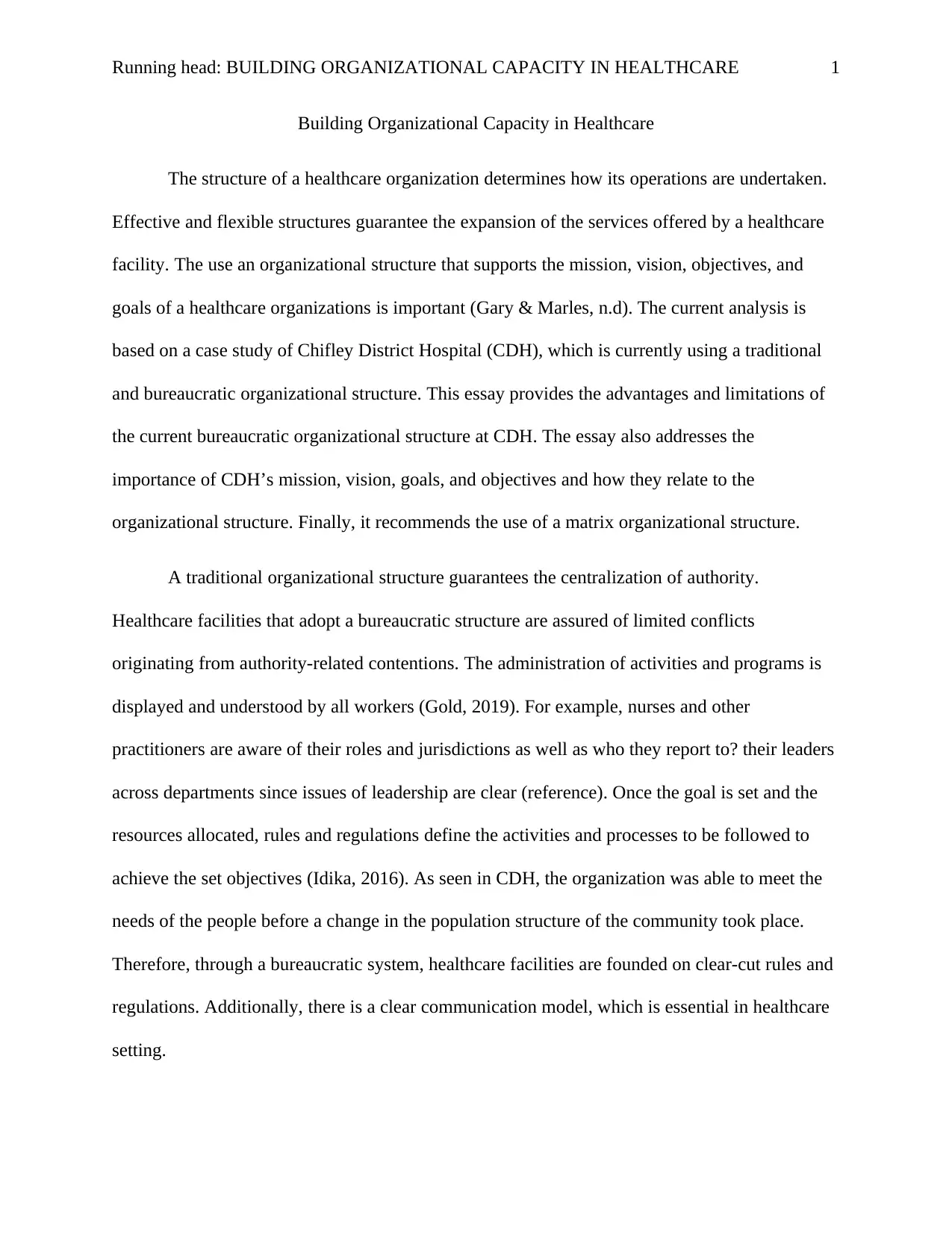
Running head: BUILDING ORGANIZATIONAL CAPACITY IN HEALTHCARE 1
Building Organizational Capacity in Healthcare
The structure of a healthcare organization determines how its operations are undertaken.
Effective and flexible structures guarantee the expansion of the services offered by a healthcare
facility. The use an organizational structure that supports the mission, vision, objectives, and
goals of a healthcare organizations is important (Gary & Marles, n.d). The current analysis is
based on a case study of Chifley District Hospital (CDH), which is currently using a traditional
and bureaucratic organizational structure. This essay provides the advantages and limitations of
the current bureaucratic organizational structure at CDH. The essay also addresses the
importance of CDH’s mission, vision, goals, and objectives and how they relate to the
organizational structure. Finally, it recommends the use of a matrix organizational structure.
A traditional organizational structure guarantees the centralization of authority.
Healthcare facilities that adopt a bureaucratic structure are assured of limited conflicts
originating from authority-related contentions. The administration of activities and programs is
displayed and understood by all workers (Gold, 2019). For example, nurses and other
practitioners are aware of their roles and jurisdictions as well as who they report to? their leaders
across departments since issues of leadership are clear (reference). Once the goal is set and the
resources allocated, rules and regulations define the activities and processes to be followed to
achieve the set objectives (Idika, 2016). As seen in CDH, the organization was able to meet the
needs of the people before a change in the population structure of the community took place.
Therefore, through a bureaucratic system, healthcare facilities are founded on clear-cut rules and
regulations. Additionally, there is a clear communication model, which is essential in healthcare
setting.
Building Organizational Capacity in Healthcare
The structure of a healthcare organization determines how its operations are undertaken.
Effective and flexible structures guarantee the expansion of the services offered by a healthcare
facility. The use an organizational structure that supports the mission, vision, objectives, and
goals of a healthcare organizations is important (Gary & Marles, n.d). The current analysis is
based on a case study of Chifley District Hospital (CDH), which is currently using a traditional
and bureaucratic organizational structure. This essay provides the advantages and limitations of
the current bureaucratic organizational structure at CDH. The essay also addresses the
importance of CDH’s mission, vision, goals, and objectives and how they relate to the
organizational structure. Finally, it recommends the use of a matrix organizational structure.
A traditional organizational structure guarantees the centralization of authority.
Healthcare facilities that adopt a bureaucratic structure are assured of limited conflicts
originating from authority-related contentions. The administration of activities and programs is
displayed and understood by all workers (Gold, 2019). For example, nurses and other
practitioners are aware of their roles and jurisdictions as well as who they report to? their leaders
across departments since issues of leadership are clear (reference). Once the goal is set and the
resources allocated, rules and regulations define the activities and processes to be followed to
achieve the set objectives (Idika, 2016). As seen in CDH, the organization was able to meet the
needs of the people before a change in the population structure of the community took place.
Therefore, through a bureaucratic system, healthcare facilities are founded on clear-cut rules and
regulations. Additionally, there is a clear communication model, which is essential in healthcare
setting.
Paraphrase This Document
Need a fresh take? Get an instant paraphrase of this document with our AI Paraphraser
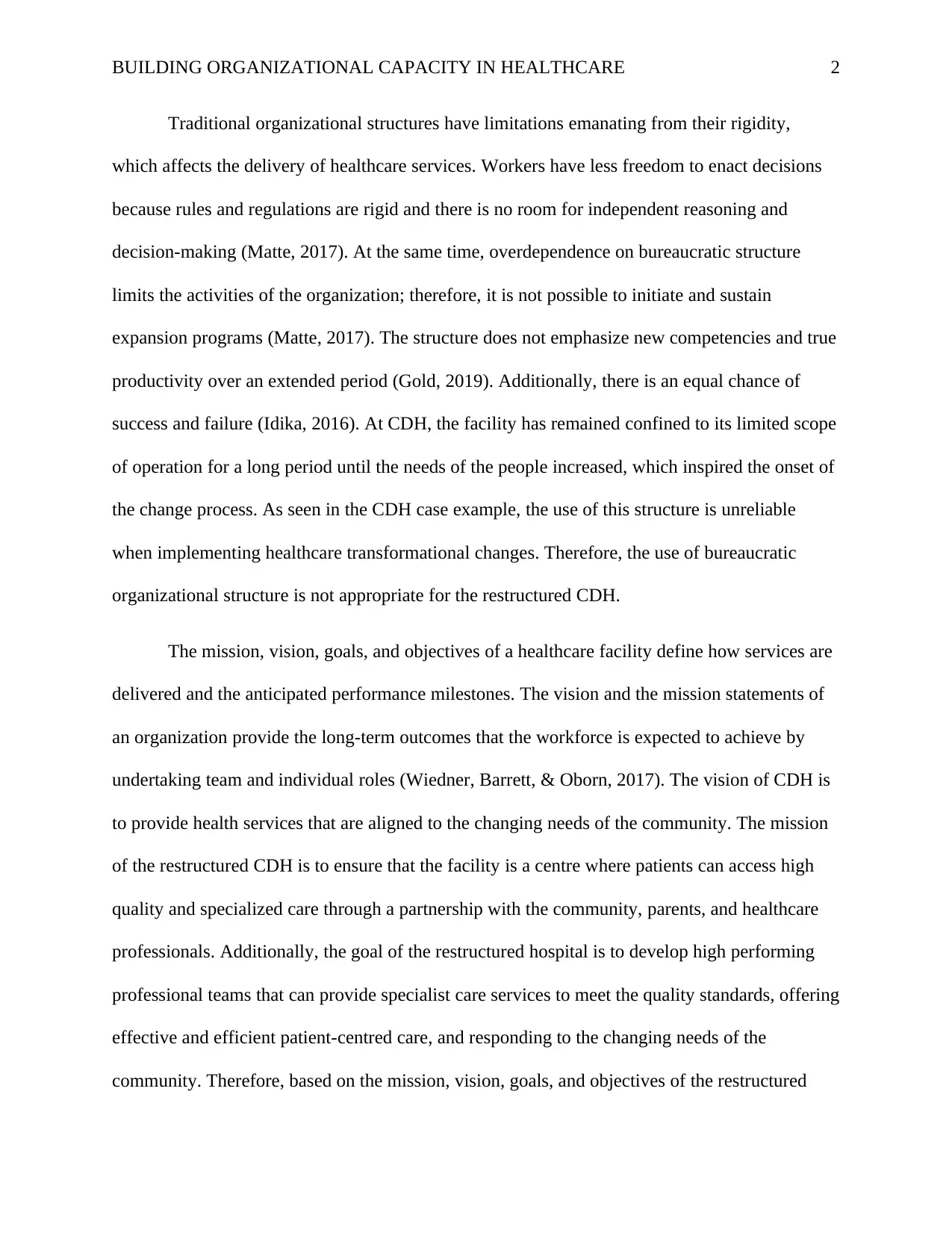
BUILDING ORGANIZATIONAL CAPACITY IN HEALTHCARE 2
Traditional organizational structures have limitations emanating from their rigidity,
which affects the delivery of healthcare services. Workers have less freedom to enact decisions
because rules and regulations are rigid and there is no room for independent reasoning and
decision-making (Matte, 2017). At the same time, overdependence on bureaucratic structure
limits the activities of the organization; therefore, it is not possible to initiate and sustain
expansion programs (Matte, 2017). The structure does not emphasize new competencies and true
productivity over an extended period (Gold, 2019). Additionally, there is an equal chance of
success and failure (Idika, 2016). At CDH, the facility has remained confined to its limited scope
of operation for a long period until the needs of the people increased, which inspired the onset of
the change process. As seen in the CDH case example, the use of this structure is unreliable
when implementing healthcare transformational changes. Therefore, the use of bureaucratic
organizational structure is not appropriate for the restructured CDH.
The mission, vision, goals, and objectives of a healthcare facility define how services are
delivered and the anticipated performance milestones. The vision and the mission statements of
an organization provide the long-term outcomes that the workforce is expected to achieve by
undertaking team and individual roles (Wiedner, Barrett, & Oborn, 2017). The vision of CDH is
to provide health services that are aligned to the changing needs of the community. The mission
of the restructured CDH is to ensure that the facility is a centre where patients can access high
quality and specialized care through a partnership with the community, parents, and healthcare
professionals. Additionally, the goal of the restructured hospital is to develop high performing
professional teams that can provide specialist care services to meet the quality standards, offering
effective and efficient patient-centred care, and responding to the changing needs of the
community. Therefore, based on the mission, vision, goals, and objectives of the restructured
Traditional organizational structures have limitations emanating from their rigidity,
which affects the delivery of healthcare services. Workers have less freedom to enact decisions
because rules and regulations are rigid and there is no room for independent reasoning and
decision-making (Matte, 2017). At the same time, overdependence on bureaucratic structure
limits the activities of the organization; therefore, it is not possible to initiate and sustain
expansion programs (Matte, 2017). The structure does not emphasize new competencies and true
productivity over an extended period (Gold, 2019). Additionally, there is an equal chance of
success and failure (Idika, 2016). At CDH, the facility has remained confined to its limited scope
of operation for a long period until the needs of the people increased, which inspired the onset of
the change process. As seen in the CDH case example, the use of this structure is unreliable
when implementing healthcare transformational changes. Therefore, the use of bureaucratic
organizational structure is not appropriate for the restructured CDH.
The mission, vision, goals, and objectives of a healthcare facility define how services are
delivered and the anticipated performance milestones. The vision and the mission statements of
an organization provide the long-term outcomes that the workforce is expected to achieve by
undertaking team and individual roles (Wiedner, Barrett, & Oborn, 2017). The vision of CDH is
to provide health services that are aligned to the changing needs of the community. The mission
of the restructured CDH is to ensure that the facility is a centre where patients can access high
quality and specialized care through a partnership with the community, parents, and healthcare
professionals. Additionally, the goal of the restructured hospital is to develop high performing
professional teams that can provide specialist care services to meet the quality standards, offering
effective and efficient patient-centred care, and responding to the changing needs of the
community. Therefore, based on the mission, vision, goals, and objectives of the restructured
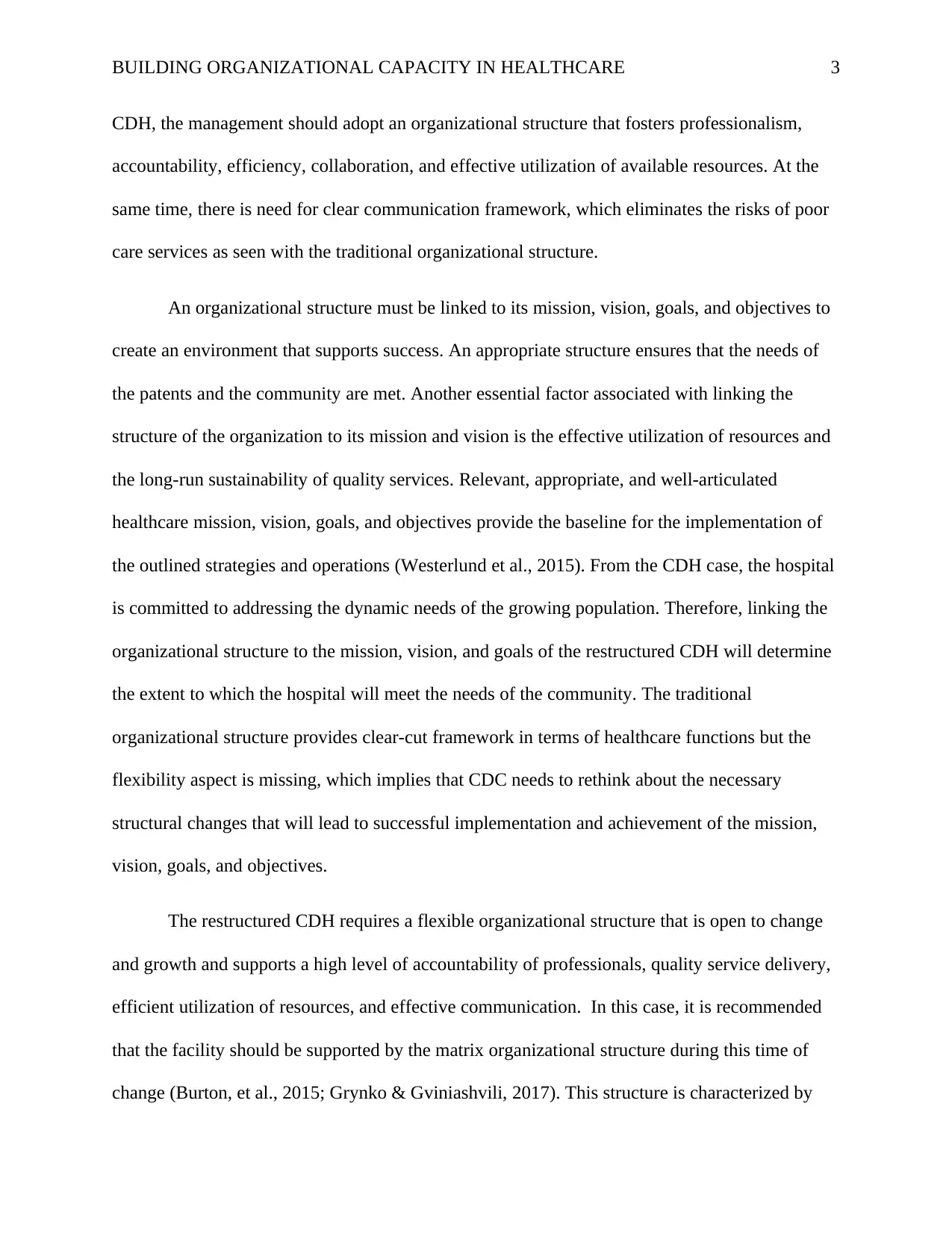
BUILDING ORGANIZATIONAL CAPACITY IN HEALTHCARE 3
CDH, the management should adopt an organizational structure that fosters professionalism,
accountability, efficiency, collaboration, and effective utilization of available resources. At the
same time, there is need for clear communication framework, which eliminates the risks of poor
care services as seen with the traditional organizational structure.
An organizational structure must be linked to its mission, vision, goals, and objectives to
create an environment that supports success. An appropriate structure ensures that the needs of
the patents and the community are met. Another essential factor associated with linking the
structure of the organization to its mission and vision is the effective utilization of resources and
the long-run sustainability of quality services. Relevant, appropriate, and well-articulated
healthcare mission, vision, goals, and objectives provide the baseline for the implementation of
the outlined strategies and operations (Westerlund et al., 2015). From the CDH case, the hospital
is committed to addressing the dynamic needs of the growing population. Therefore, linking the
organizational structure to the mission, vision, and goals of the restructured CDH will determine
the extent to which the hospital will meet the needs of the community. The traditional
organizational structure provides clear-cut framework in terms of healthcare functions but the
flexibility aspect is missing, which implies that CDC needs to rethink about the necessary
structural changes that will lead to successful implementation and achievement of the mission,
vision, goals, and objectives.
The restructured CDH requires a flexible organizational structure that is open to change
and growth and supports a high level of accountability of professionals, quality service delivery,
efficient utilization of resources, and effective communication. In this case, it is recommended
that the facility should be supported by the matrix organizational structure during this time of
change (Burton, et al., 2015; Grуnko & Gviniashvili, 2017). This structure is characterized by
CDH, the management should adopt an organizational structure that fosters professionalism,
accountability, efficiency, collaboration, and effective utilization of available resources. At the
same time, there is need for clear communication framework, which eliminates the risks of poor
care services as seen with the traditional organizational structure.
An organizational structure must be linked to its mission, vision, goals, and objectives to
create an environment that supports success. An appropriate structure ensures that the needs of
the patents and the community are met. Another essential factor associated with linking the
structure of the organization to its mission and vision is the effective utilization of resources and
the long-run sustainability of quality services. Relevant, appropriate, and well-articulated
healthcare mission, vision, goals, and objectives provide the baseline for the implementation of
the outlined strategies and operations (Westerlund et al., 2015). From the CDH case, the hospital
is committed to addressing the dynamic needs of the growing population. Therefore, linking the
organizational structure to the mission, vision, and goals of the restructured CDH will determine
the extent to which the hospital will meet the needs of the community. The traditional
organizational structure provides clear-cut framework in terms of healthcare functions but the
flexibility aspect is missing, which implies that CDC needs to rethink about the necessary
structural changes that will lead to successful implementation and achievement of the mission,
vision, goals, and objectives.
The restructured CDH requires a flexible organizational structure that is open to change
and growth and supports a high level of accountability of professionals, quality service delivery,
efficient utilization of resources, and effective communication. In this case, it is recommended
that the facility should be supported by the matrix organizational structure during this time of
change (Burton, et al., 2015; Grуnko & Gviniashvili, 2017). This structure is characterized by
⊘ This is a preview!⊘
Do you want full access?
Subscribe today to unlock all pages.

Trusted by 1+ million students worldwide
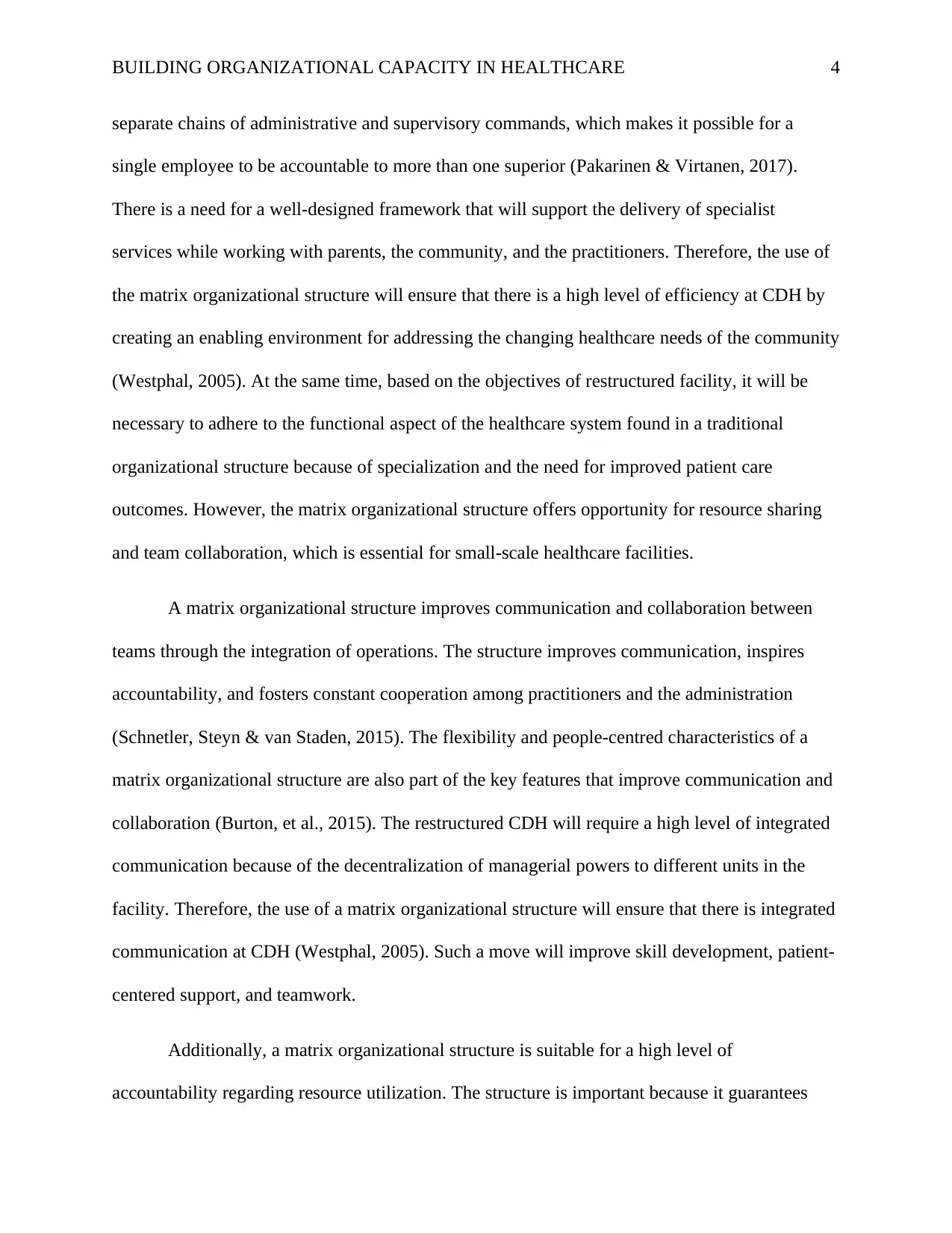
BUILDING ORGANIZATIONAL CAPACITY IN HEALTHCARE 4
separate chains of administrative and supervisory commands, which makes it possible for a
single employee to be accountable to more than one superior (Pakarinen & Virtanen, 2017).
There is a need for a well-designed framework that will support the delivery of specialist
services while working with parents, the community, and the practitioners. Therefore, the use of
the matrix organizational structure will ensure that there is a high level of efficiency at CDH by
creating an enabling environment for addressing the changing healthcare needs of the community
(Westphal, 2005). At the same time, based on the objectives of restructured facility, it will be
necessary to adhere to the functional aspect of the healthcare system found in a traditional
organizational structure because of specialization and the need for improved patient care
outcomes. However, the matrix organizational structure offers opportunity for resource sharing
and team collaboration, which is essential for small-scale healthcare facilities.
A matrix organizational structure improves communication and collaboration between
teams through the integration of operations. The structure improves communication, inspires
accountability, and fosters constant cooperation among practitioners and the administration
(Schnetler, Steyn & van Staden, 2015). The flexibility and people-centred characteristics of a
matrix organizational structure are also part of the key features that improve communication and
collaboration (Burton, et al., 2015). The restructured CDH will require a high level of integrated
communication because of the decentralization of managerial powers to different units in the
facility. Therefore, the use of a matrix organizational structure will ensure that there is integrated
communication at CDH (Westphal, 2005). Such a move will improve skill development, patient-
centered support, and teamwork.
Additionally, a matrix organizational structure is suitable for a high level of
accountability regarding resource utilization. The structure is important because it guarantees
separate chains of administrative and supervisory commands, which makes it possible for a
single employee to be accountable to more than one superior (Pakarinen & Virtanen, 2017).
There is a need for a well-designed framework that will support the delivery of specialist
services while working with parents, the community, and the practitioners. Therefore, the use of
the matrix organizational structure will ensure that there is a high level of efficiency at CDH by
creating an enabling environment for addressing the changing healthcare needs of the community
(Westphal, 2005). At the same time, based on the objectives of restructured facility, it will be
necessary to adhere to the functional aspect of the healthcare system found in a traditional
organizational structure because of specialization and the need for improved patient care
outcomes. However, the matrix organizational structure offers opportunity for resource sharing
and team collaboration, which is essential for small-scale healthcare facilities.
A matrix organizational structure improves communication and collaboration between
teams through the integration of operations. The structure improves communication, inspires
accountability, and fosters constant cooperation among practitioners and the administration
(Schnetler, Steyn & van Staden, 2015). The flexibility and people-centred characteristics of a
matrix organizational structure are also part of the key features that improve communication and
collaboration (Burton, et al., 2015). The restructured CDH will require a high level of integrated
communication because of the decentralization of managerial powers to different units in the
facility. Therefore, the use of a matrix organizational structure will ensure that there is integrated
communication at CDH (Westphal, 2005). Such a move will improve skill development, patient-
centered support, and teamwork.
Additionally, a matrix organizational structure is suitable for a high level of
accountability regarding resource utilization. The structure is important because it guarantees
Paraphrase This Document
Need a fresh take? Get an instant paraphrase of this document with our AI Paraphraser
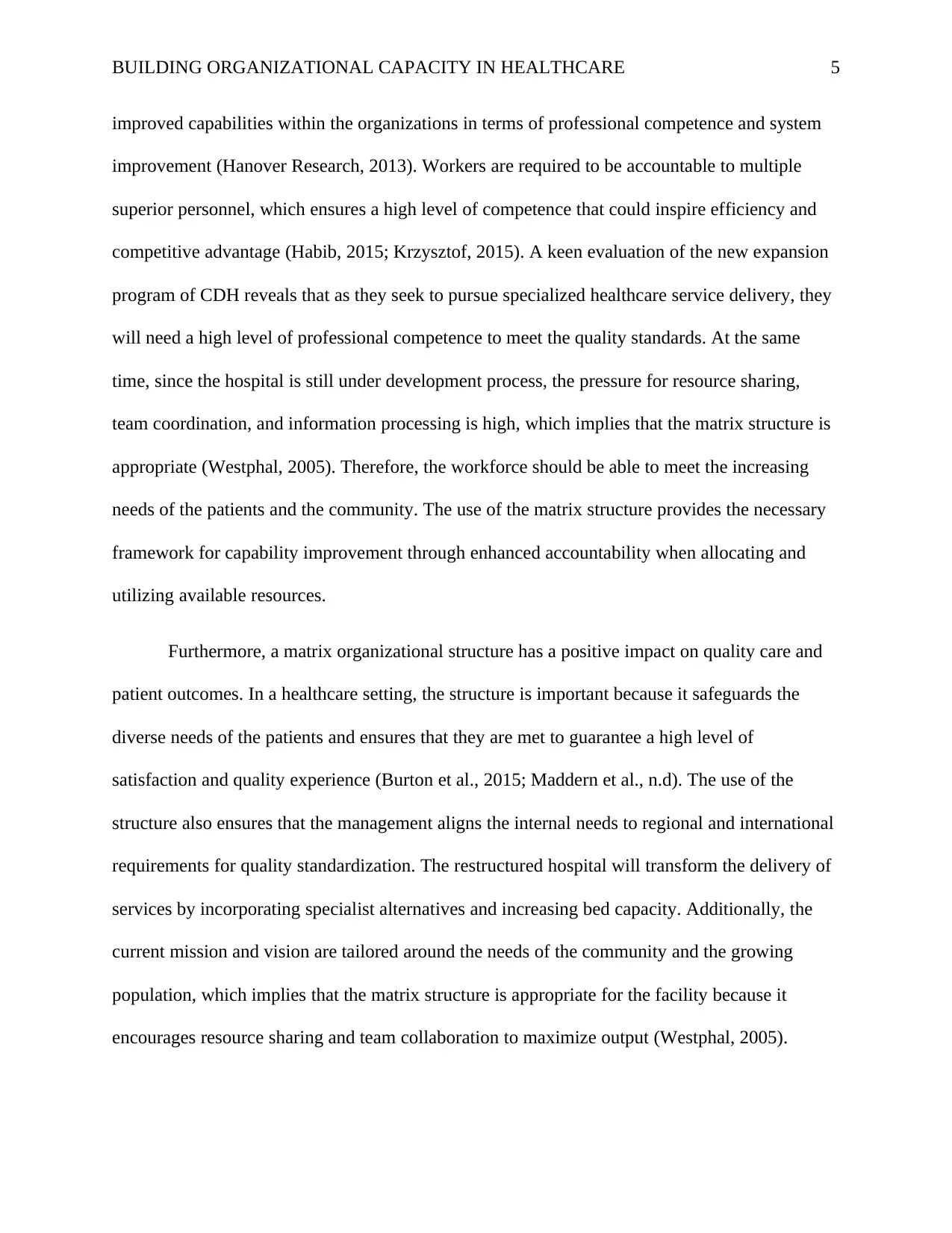
BUILDING ORGANIZATIONAL CAPACITY IN HEALTHCARE 5
improved capabilities within the organizations in terms of professional competence and system
improvement (Hanover Research, 2013). Workers are required to be accountable to multiple
superior personnel, which ensures a high level of competence that could inspire efficiency and
competitive advantage (Habib, 2015; Krzysztof, 2015). A keen evaluation of the new expansion
program of CDH reveals that as they seek to pursue specialized healthcare service delivery, they
will need a high level of professional competence to meet the quality standards. At the same
time, since the hospital is still under development process, the pressure for resource sharing,
team coordination, and information processing is high, which implies that the matrix structure is
appropriate (Westphal, 2005). Therefore, the workforce should be able to meet the increasing
needs of the patients and the community. The use of the matrix structure provides the necessary
framework for capability improvement through enhanced accountability when allocating and
utilizing available resources.
Furthermore, a matrix organizational structure has a positive impact on quality care and
patient outcomes. In a healthcare setting, the structure is important because it safeguards the
diverse needs of the patients and ensures that they are met to guarantee a high level of
satisfaction and quality experience (Burton et al., 2015; Maddern et al., n.d). The use of the
structure also ensures that the management aligns the internal needs to regional and international
requirements for quality standardization. The restructured hospital will transform the delivery of
services by incorporating specialist alternatives and increasing bed capacity. Additionally, the
current mission and vision are tailored around the needs of the community and the growing
population, which implies that the matrix structure is appropriate for the facility because it
encourages resource sharing and team collaboration to maximize output (Westphal, 2005).
improved capabilities within the organizations in terms of professional competence and system
improvement (Hanover Research, 2013). Workers are required to be accountable to multiple
superior personnel, which ensures a high level of competence that could inspire efficiency and
competitive advantage (Habib, 2015; Krzysztof, 2015). A keen evaluation of the new expansion
program of CDH reveals that as they seek to pursue specialized healthcare service delivery, they
will need a high level of professional competence to meet the quality standards. At the same
time, since the hospital is still under development process, the pressure for resource sharing,
team coordination, and information processing is high, which implies that the matrix structure is
appropriate (Westphal, 2005). Therefore, the workforce should be able to meet the increasing
needs of the patients and the community. The use of the matrix structure provides the necessary
framework for capability improvement through enhanced accountability when allocating and
utilizing available resources.
Furthermore, a matrix organizational structure has a positive impact on quality care and
patient outcomes. In a healthcare setting, the structure is important because it safeguards the
diverse needs of the patients and ensures that they are met to guarantee a high level of
satisfaction and quality experience (Burton et al., 2015; Maddern et al., n.d). The use of the
structure also ensures that the management aligns the internal needs to regional and international
requirements for quality standardization. The restructured hospital will transform the delivery of
services by incorporating specialist alternatives and increasing bed capacity. Additionally, the
current mission and vision are tailored around the needs of the community and the growing
population, which implies that the matrix structure is appropriate for the facility because it
encourages resource sharing and team collaboration to maximize output (Westphal, 2005).
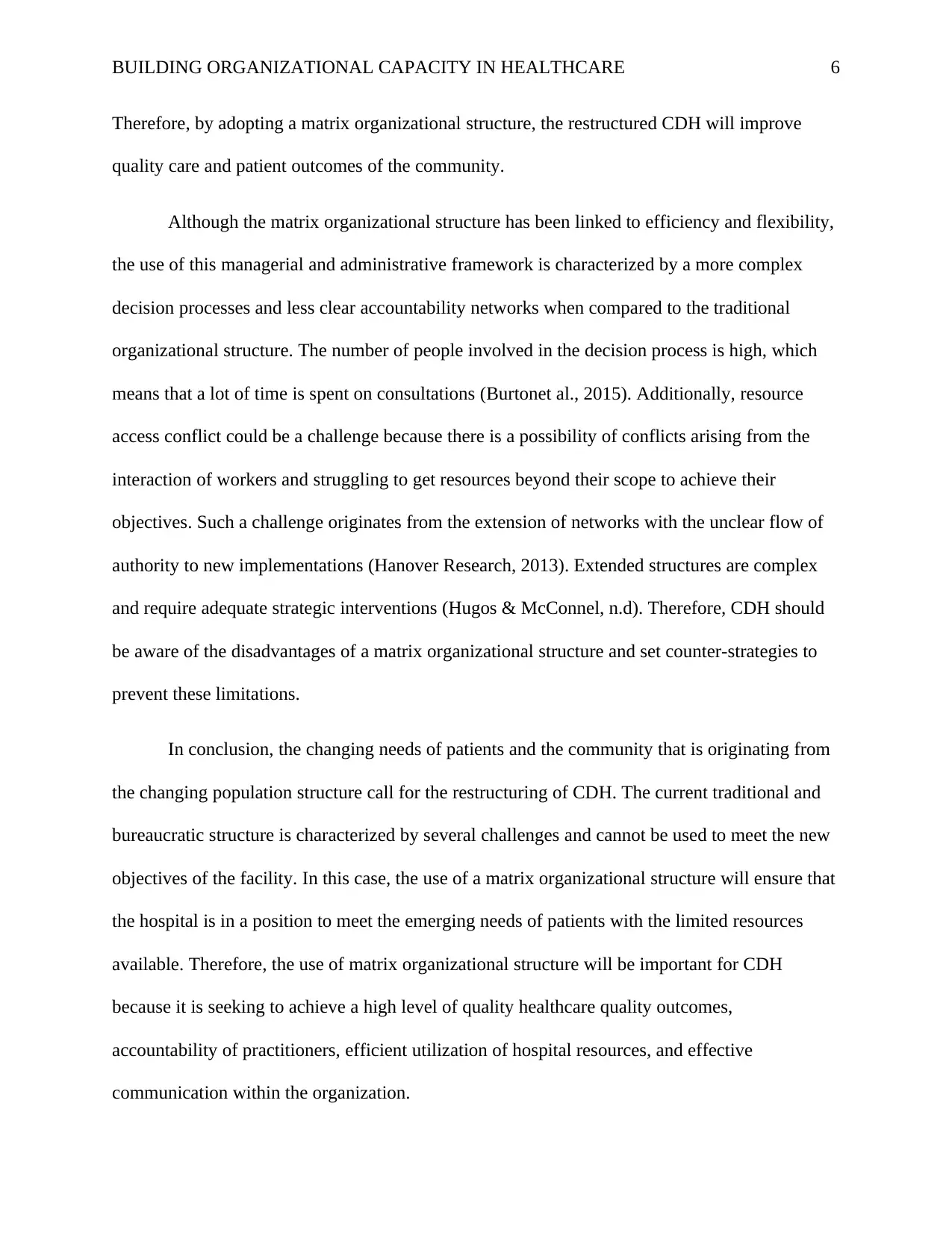
BUILDING ORGANIZATIONAL CAPACITY IN HEALTHCARE 6
Therefore, by adopting a matrix organizational structure, the restructured CDH will improve
quality care and patient outcomes of the community.
Although the matrix organizational structure has been linked to efficiency and flexibility,
the use of this managerial and administrative framework is characterized by a more complex
decision processes and less clear accountability networks when compared to the traditional
organizational structure. The number of people involved in the decision process is high, which
means that a lot of time is spent on consultations (Burtonet al., 2015). Additionally, resource
access conflict could be a challenge because there is a possibility of conflicts arising from the
interaction of workers and struggling to get resources beyond their scope to achieve their
objectives. Such a challenge originates from the extension of networks with the unclear flow of
authority to new implementations (Hanover Research, 2013). Extended structures are complex
and require adequate strategic interventions (Hugos & McConnel, n.d). Therefore, CDH should
be aware of the disadvantages of a matrix organizational structure and set counter-strategies to
prevent these limitations.
In conclusion, the changing needs of patients and the community that is originating from
the changing population structure call for the restructuring of CDH. The current traditional and
bureaucratic structure is characterized by several challenges and cannot be used to meet the new
objectives of the facility. In this case, the use of a matrix organizational structure will ensure that
the hospital is in a position to meet the emerging needs of patients with the limited resources
available. Therefore, the use of matrix organizational structure will be important for CDH
because it is seeking to achieve a high level of quality healthcare quality outcomes,
accountability of practitioners, efficient utilization of hospital resources, and effective
communication within the organization.
Therefore, by adopting a matrix organizational structure, the restructured CDH will improve
quality care and patient outcomes of the community.
Although the matrix organizational structure has been linked to efficiency and flexibility,
the use of this managerial and administrative framework is characterized by a more complex
decision processes and less clear accountability networks when compared to the traditional
organizational structure. The number of people involved in the decision process is high, which
means that a lot of time is spent on consultations (Burtonet al., 2015). Additionally, resource
access conflict could be a challenge because there is a possibility of conflicts arising from the
interaction of workers and struggling to get resources beyond their scope to achieve their
objectives. Such a challenge originates from the extension of networks with the unclear flow of
authority to new implementations (Hanover Research, 2013). Extended structures are complex
and require adequate strategic interventions (Hugos & McConnel, n.d). Therefore, CDH should
be aware of the disadvantages of a matrix organizational structure and set counter-strategies to
prevent these limitations.
In conclusion, the changing needs of patients and the community that is originating from
the changing population structure call for the restructuring of CDH. The current traditional and
bureaucratic structure is characterized by several challenges and cannot be used to meet the new
objectives of the facility. In this case, the use of a matrix organizational structure will ensure that
the hospital is in a position to meet the emerging needs of patients with the limited resources
available. Therefore, the use of matrix organizational structure will be important for CDH
because it is seeking to achieve a high level of quality healthcare quality outcomes,
accountability of practitioners, efficient utilization of hospital resources, and effective
communication within the organization.
⊘ This is a preview!⊘
Do you want full access?
Subscribe today to unlock all pages.

Trusted by 1+ million students worldwide
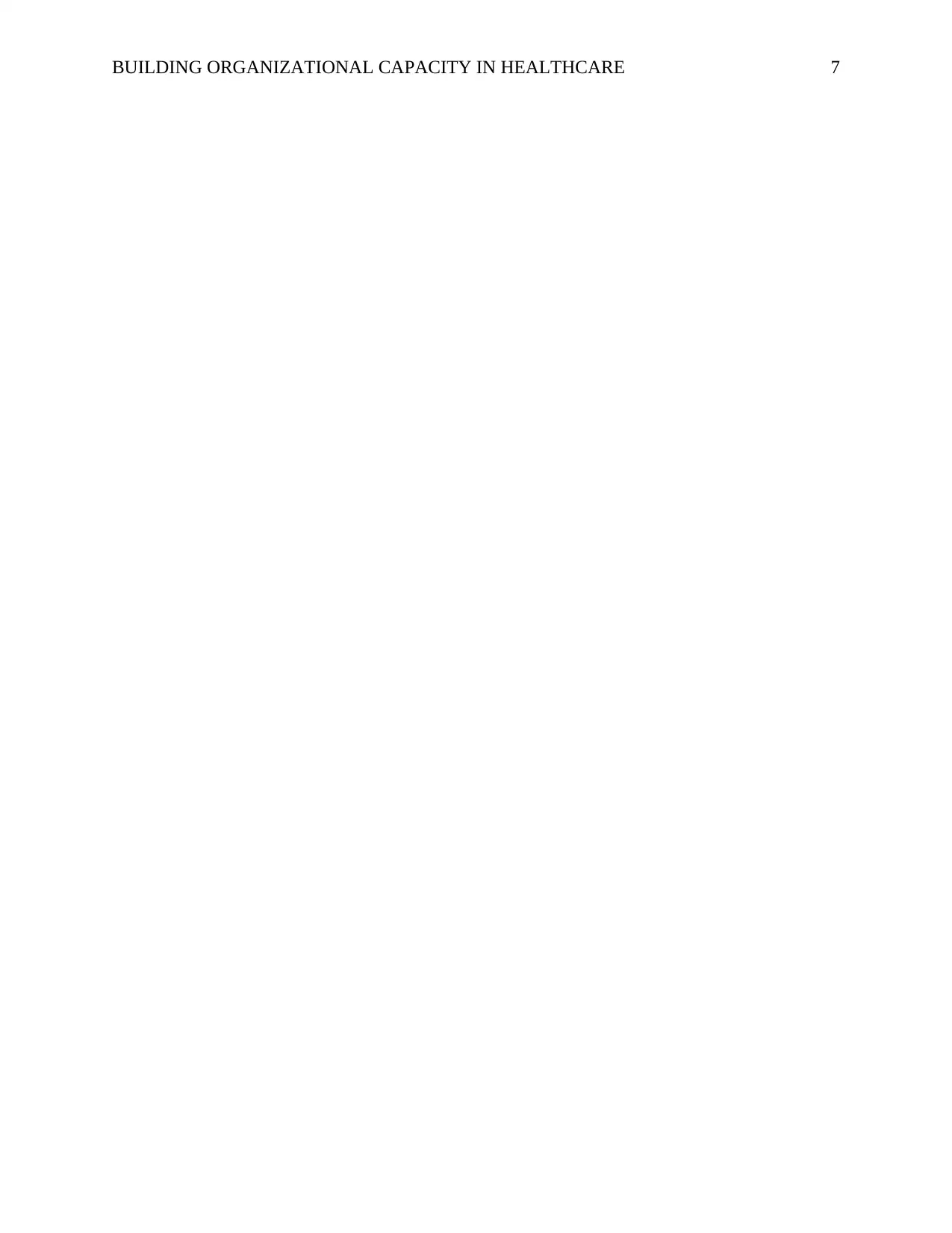
BUILDING ORGANIZATIONAL CAPACITY IN HEALTHCARE 7
Paraphrase This Document
Need a fresh take? Get an instant paraphrase of this document with our AI Paraphraser
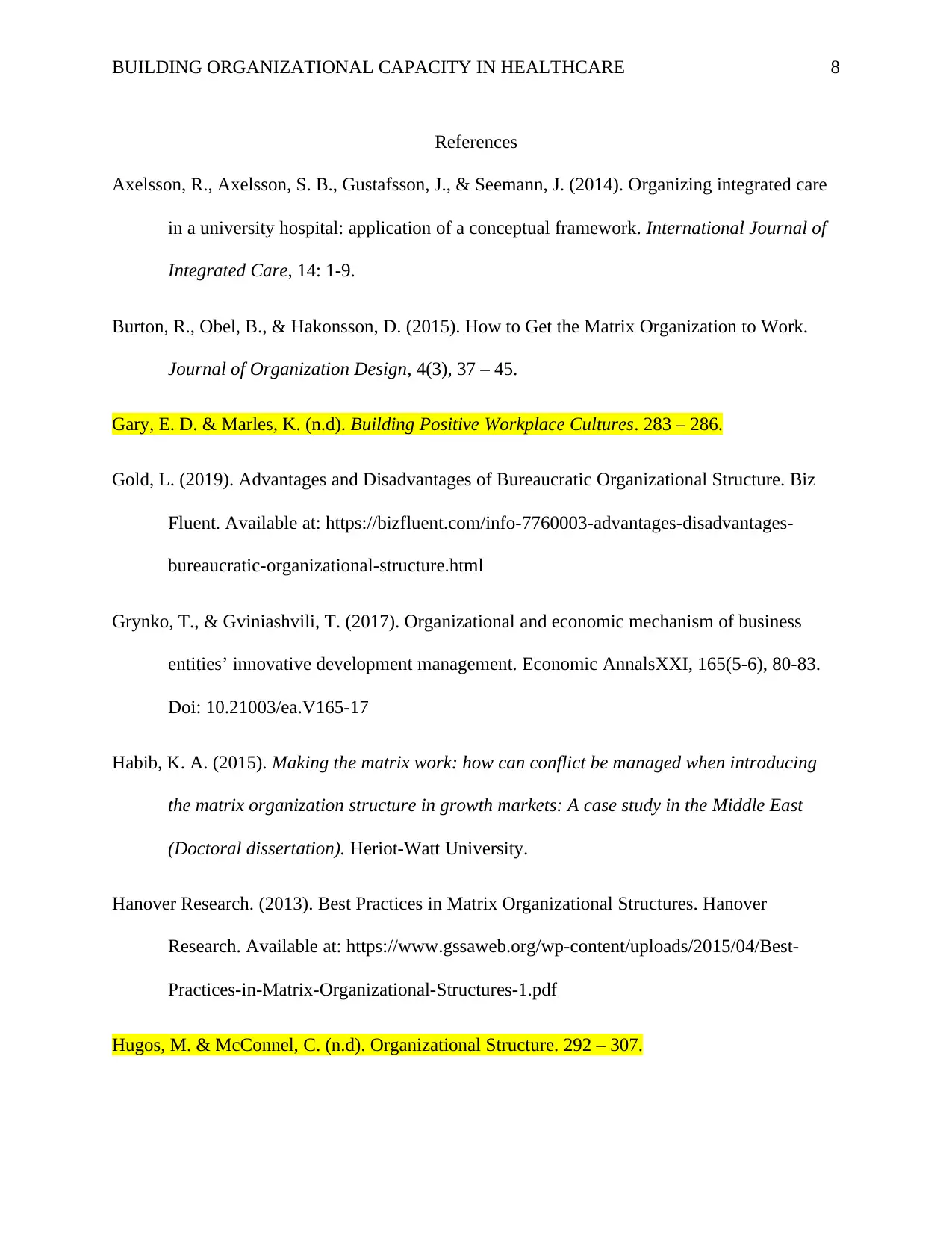
BUILDING ORGANIZATIONAL CAPACITY IN HEALTHCARE 8
References
Axelsson, R., Axelsson, S. B., Gustafsson, J., & Seemann, J. (2014). Organizing integrated care
in a university hospital: application of a conceptual framework. International Journal of
Integrated Care, 14: 1-9.
Burton, R., Obel, B., & Hakonsson, D. (2015). How to Get the Matrix Organization to Work.
Journal of Organization Design, 4(3), 37 – 45.
Gary, E. D. & Marles, K. (n.d). Building Positive Workplace Cultures. 283 – 286.
Gold, L. (2019). Advantages and Disadvantages of Bureaucratic Organizational Structure. Biz
Fluent. Available at: https://bizfluent.com/info-7760003-advantages-disadvantages-
bureaucratic-organizational-structure.html
Grуnko, T., & Gviniashvili, T. (2017). Organizational and economic mechanism of business
entities’ innovative development management. Economic AnnalsXXI, 165(5-6), 80-83.
Doi: 10.21003/ea.V165-17
Habib, K. A. (2015). Making the matrix work: how can conflict be managed when introducing
the matrix organization structure in growth markets: A case study in the Middle East
(Doctoral dissertation). Heriot-Watt University.
Hanover Research. (2013). Best Practices in Matrix Organizational Structures. Hanover
Research. Available at: https://www.gssaweb.org/wp-content/uploads/2015/04/Best-
Practices-in-Matrix-Organizational-Structures-1.pdf
Hugos, M. & McConnel, C. (n.d). Organizational Structure. 292 – 307.
References
Axelsson, R., Axelsson, S. B., Gustafsson, J., & Seemann, J. (2014). Organizing integrated care
in a university hospital: application of a conceptual framework. International Journal of
Integrated Care, 14: 1-9.
Burton, R., Obel, B., & Hakonsson, D. (2015). How to Get the Matrix Organization to Work.
Journal of Organization Design, 4(3), 37 – 45.
Gary, E. D. & Marles, K. (n.d). Building Positive Workplace Cultures. 283 – 286.
Gold, L. (2019). Advantages and Disadvantages of Bureaucratic Organizational Structure. Biz
Fluent. Available at: https://bizfluent.com/info-7760003-advantages-disadvantages-
bureaucratic-organizational-structure.html
Grуnko, T., & Gviniashvili, T. (2017). Organizational and economic mechanism of business
entities’ innovative development management. Economic AnnalsXXI, 165(5-6), 80-83.
Doi: 10.21003/ea.V165-17
Habib, K. A. (2015). Making the matrix work: how can conflict be managed when introducing
the matrix organization structure in growth markets: A case study in the Middle East
(Doctoral dissertation). Heriot-Watt University.
Hanover Research. (2013). Best Practices in Matrix Organizational Structures. Hanover
Research. Available at: https://www.gssaweb.org/wp-content/uploads/2015/04/Best-
Practices-in-Matrix-Organizational-Structures-1.pdf
Hugos, M. & McConnel, C. (n.d). Organizational Structure. 292 – 307.
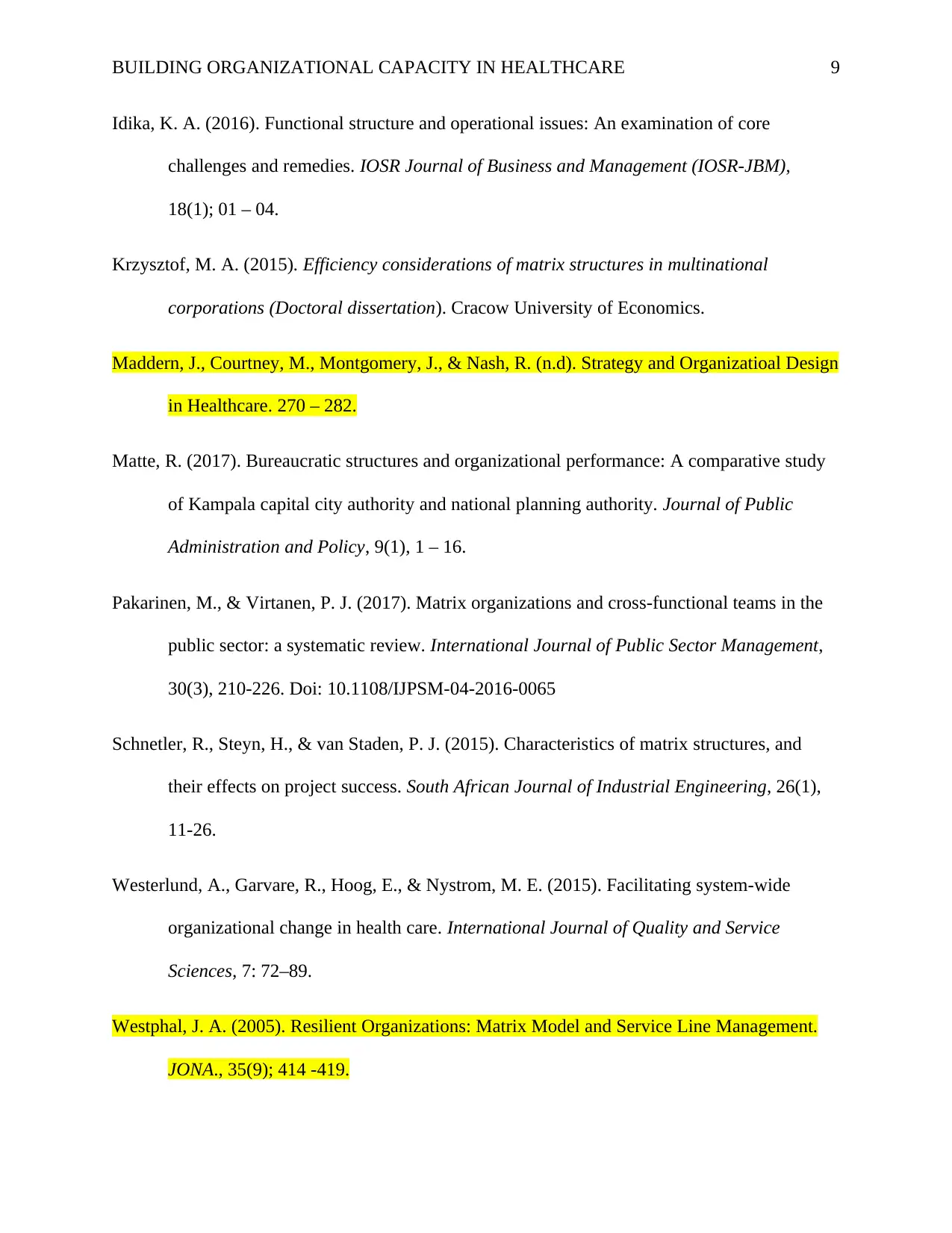
BUILDING ORGANIZATIONAL CAPACITY IN HEALTHCARE 9
Idika, K. A. (2016). Functional structure and operational issues: An examination of core
challenges and remedies. IOSR Journal of Business and Management (IOSR-JBM),
18(1); 01 – 04.
Krzysztof, M. A. (2015). Efficiency considerations of matrix structures in multinational
corporations (Doctoral dissertation). Cracow University of Economics.
Maddern, J., Courtney, M., Montgomery, J., & Nash, R. (n.d). Strategy and Organizatioal Design
in Healthcare. 270 – 282.
Matte, R. (2017). Bureaucratic structures and organizational performance: A comparative study
of Kampala capital city authority and national planning authority. Journal of Public
Administration and Policy, 9(1), 1 – 16.
Pakarinen, M., & Virtanen, P. J. (2017). Matrix organizations and cross-functional teams in the
public sector: a systematic review. International Journal of Public Sector Management,
30(3), 210-226. Doi: 10.1108/IJPSM-04-2016-0065
Schnetler, R., Steyn, H., & van Staden, P. J. (2015). Characteristics of matrix structures, and
their effects on project success. South African Journal of Industrial Engineering, 26(1),
11-26.
Westerlund, A., Garvare, R., Hoog, E., & Nystrom, M. E. (2015). Facilitating system-wide
organizational change in health care. International Journal of Quality and Service
Sciences, 7: 72–89.
Westphal, J. A. (2005). Resilient Organizations: Matrix Model and Service Line Management.
JONA., 35(9); 414 -419.
Idika, K. A. (2016). Functional structure and operational issues: An examination of core
challenges and remedies. IOSR Journal of Business and Management (IOSR-JBM),
18(1); 01 – 04.
Krzysztof, M. A. (2015). Efficiency considerations of matrix structures in multinational
corporations (Doctoral dissertation). Cracow University of Economics.
Maddern, J., Courtney, M., Montgomery, J., & Nash, R. (n.d). Strategy and Organizatioal Design
in Healthcare. 270 – 282.
Matte, R. (2017). Bureaucratic structures and organizational performance: A comparative study
of Kampala capital city authority and national planning authority. Journal of Public
Administration and Policy, 9(1), 1 – 16.
Pakarinen, M., & Virtanen, P. J. (2017). Matrix organizations and cross-functional teams in the
public sector: a systematic review. International Journal of Public Sector Management,
30(3), 210-226. Doi: 10.1108/IJPSM-04-2016-0065
Schnetler, R., Steyn, H., & van Staden, P. J. (2015). Characteristics of matrix structures, and
their effects on project success. South African Journal of Industrial Engineering, 26(1),
11-26.
Westerlund, A., Garvare, R., Hoog, E., & Nystrom, M. E. (2015). Facilitating system-wide
organizational change in health care. International Journal of Quality and Service
Sciences, 7: 72–89.
Westphal, J. A. (2005). Resilient Organizations: Matrix Model and Service Line Management.
JONA., 35(9); 414 -419.
⊘ This is a preview!⊘
Do you want full access?
Subscribe today to unlock all pages.

Trusted by 1+ million students worldwide
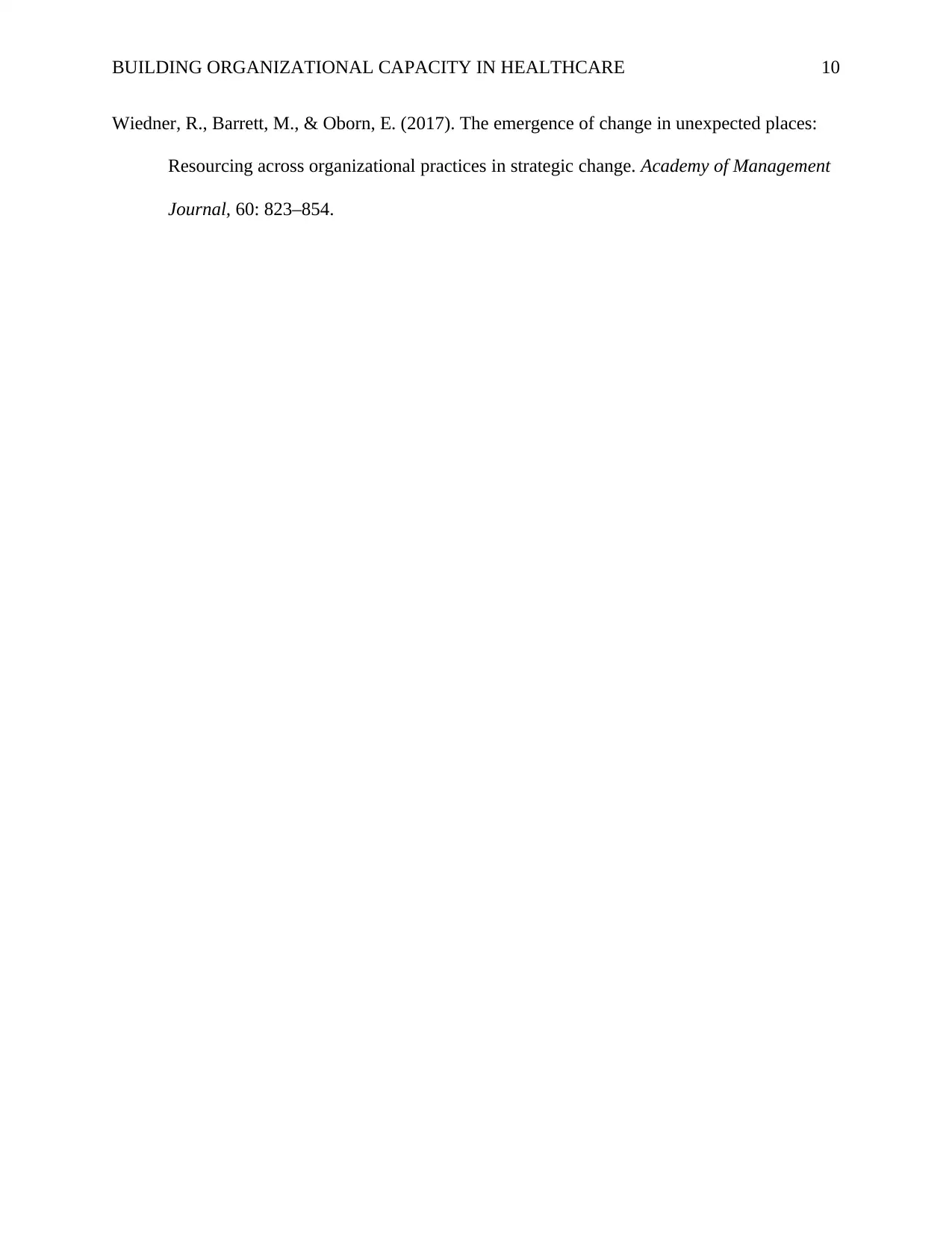
BUILDING ORGANIZATIONAL CAPACITY IN HEALTHCARE 10
Wiedner, R., Barrett, M., & Oborn, E. (2017). The emergence of change in unexpected places:
Resourcing across organizational practices in strategic change. Academy of Management
Journal, 60: 823–854.
Wiedner, R., Barrett, M., & Oborn, E. (2017). The emergence of change in unexpected places:
Resourcing across organizational practices in strategic change. Academy of Management
Journal, 60: 823–854.
1 out of 10
Related Documents
Your All-in-One AI-Powered Toolkit for Academic Success.
+13062052269
info@desklib.com
Available 24*7 on WhatsApp / Email
![[object Object]](/_next/static/media/star-bottom.7253800d.svg)
Unlock your academic potential
Copyright © 2020–2025 A2Z Services. All Rights Reserved. Developed and managed by ZUCOL.





